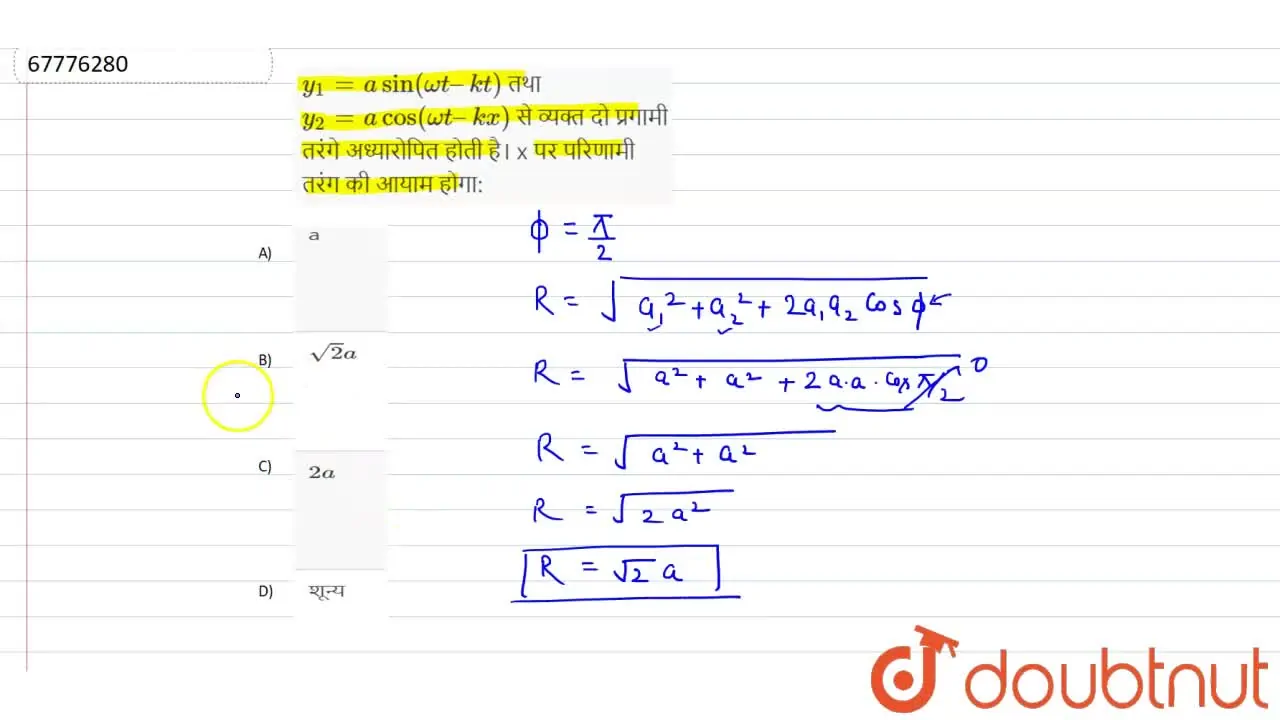तथा से व्यक्त दो प्रगामी तरंगे अध्यारोपित होती है। x पर परिणामी तरंग की आयाम होगा:
a
शून्य
The correct Answer is:B
दी गई तरगों (जिनमें प्रत्येक का आयाम a है ) के बीच कलान्तर है। अतः
Related Playlists
- BOOK - NOOTAN HINDICHAPTER - व्यतिकरण EXERCISE - आंकिक30videos
व्यतिकरण
- BOOK - NOOTAN HINDICHAPTER - वैधुत विभव EXERCISE - विविध प्रतियोगी परीक्षाओ के लिए (वस्तुनिष्ठ प्रकार प्रश्न एकल उत्तर प्रकार)17videos
वैधुत विभव
- BOOK - NOOTAN HINDICHAPTER - संचार व्यवस्था EXERCISE - विविध प्रतियोगी परीक्षाओं के लिए (वस्तुनिष्ट प्रकार प्रशन) एकक उत्तर प्रकार22videos
संचार व्यवस्था
Similar Questions
एक ही आवृति तथा एक ही आयाम a की दो तरगे किसी बिन्दु पर एक साथ पहुँच रही है। तरंगों के बीच कितना कलान्तर हो कि परिणामी तरंग का आयाम : (i)2a,(ii)√2a,(iii)a तथा (iv) शून्य हो ।
04:50View Solutionएक आवेश Q लम्बाई L की छड़ AB के अनुदिश एकसमान रूप से वितरित है जैसा कि चित्र में दिखाया गया है । एक बिंदु O पर जो सिरे A से L दूरी पर है , वैधुत विभव है :
 02:43View Solution
02:43View Solutionनिमन्लिखित में से किस आवृति की तरंग आयनमंडल की उस परत से वापस हो जाएगी जिसका इलेक्ट्रान घनत्व 1011मीटर−3 है?
04:15View SolutionLet the two waves y_(1) = A sin ( kx - omega t) and y_(2) = A sin ( kx + omega t) from a standing wave on a string . Now if an additional phase difference of phi is created between two waves , then
01:07View SolutionTwo wave are represented by equation y_(1) = a sin omega t and y_(2) = a cos omega t the first wave :-
02:16View SolutionStatement-1 : The superposition of the waves y1=Asin(kx−ωt) and y2=3Asin(kx+ωt) is a pure standing wave plus a travelling wave moving in the negative direction along X-axis
Statement-2 : The resultant of y1 & y2 is y=y1+y2=2Asinkxcosωt+2Asin(kx+ωt).02:41View SolutionTwo waves are given byy1=asin(ωt−kx) and y2=acos(ωt−kx). The phase difference between the two waves is
View SolutionWave equations of two particles are given by y_(1)=a sin (omega t -kx), y_(2)=a sin (kx + omega t) , then
03:01View SolutionThree waves y_(1), y_(2) ,y_(3) are given by y_(1)= A sin (Kx- omegat), y_(2) A= sin (Kx+ omega t) and y_(3) = A sin (Ky- omega t) . Which one of the following represents wave ?
01:45View Solutiony_(1) = 4 sin (omega t + kx), y_(2) =-4 cos(omega t + kx) , the phase difference is
02:16View SolutionTwo waves are represented by
y1=a1cos(ωt−kx) and
y2=a2sin(ωt−kx+π/3)
Then the phase difference between them is-02:16View Solutiony1=asinωt और y2=bcosωt द्वारा निरूपित दो तरंगों में कलान्तर है :
02:50View Solutiony1=asin(ωt−kx) तथा y2=acos(ωt−kx) दो तरंगें दी गई हैं दोनों तरंगों के बीच कलान्तर है
03:06View Solutionदो तरंगों के समीकरण है
y1=asin(ωt−kx) तथा y2=acos(ωt–kx)
दो तरंगों के बीच कलांतर है01:46View SolutionWhen the waves y_(1) = A sin omega t and y_(2) = A cos omega t are superposed, then resultant amplitude will be
04:09View Solution


